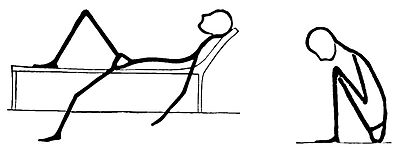advantage in cases of severe and persistent headache, where other remedies fail to relieve. Even where such a strong irritant as snuff is not resorted to, smelling salts (sal volatile) or aromatic vinegar may give considerable relief in headache if frequently inhaled.
While stimulation of the fifth nerve as just described tends to keep people awake and increase their mental activity, gentle, rhythmical stroking of the head tends, on the contrary, to make them fall asleep, and brushing the hair has this effect on many people to such an extent that the movements of the hair-dresser's fingers over the scalp, and rhythmical click of the shears, will
 | ||
| Fig. 13. | Fig. 14. | |
send some people to sleep, even at the risk of having their hair shorn to a much greater extent than would be at all pleasing to them on awakening. A gentle rubbing of the scalp, as if to loosen it upon the skull, also tends not only to soothe irritability, but to relieve and to prevent headaches.
External temperature has a powerful effect in determining posture. On a hot summer's day the natural tendency is to lie down with the head slightly raised, the arms hanging loose, and one leg extended, while the other perhaps is drawn up, as in Fig. 13. The physiological reason for this posture is that in it the greatest extent of cooling is attained, for it insures the greatest possible exposure of the largest vascular district in the body—viz., the intestinal vessels—to the cooling influence of the external air. This is aided by the loss of heat due to the evaporation of sweat. By the slight raising of the head and the drawing up of one leg, the abdominal parietes are rendered loose, and the intestines tend to fall sideways, and the abdomen tends to become flattened from before backward. The greatest extent of cooling surface is thus obtained, and the temperature of the body is kept as low as possible.
An entirely opposite attitude is assumed when the external air is cold (Fig. 14). The thin abdominal walls being insufficient to protect the intestinal vessels from the cooling influence of the external air, the legs are drawn up until the thick muscles of the thigh form a warm covering to the abdomen and thus prevent
